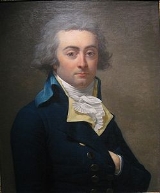
Jean-Louis Laneuville
Encyclopedia

France
The French Republic , The French Republic , The French Republic , (commonly known as France , is a unitary semi-presidential republic in Western Europe with several overseas territories and islands located on other continents and in the Indian, Pacific, and Atlantic oceans. Metropolitan France...
painter best known for his portraits during the French Revolution
French Revolution
The French Revolution , sometimes distinguished as the 'Great French Revolution' , was a period of radical social and political upheaval in France and Europe. The absolute monarchy that had ruled France for centuries collapsed in three years...
.
Laneuville was born in Paris
Paris
Paris is the capital and largest city in France, situated on the river Seine, in northern France, at the heart of the Île-de-France region...
, studied under his contemporary Jacques-Louis David
Jacques-Louis David
Jacques-Louis David was an influential French painter in the Neoclassical style, considered to be the preeminent painter of the era...
, and exhibited at the Salon de la Jeunesse from 1783-1789. During the French Revolution
French Revolution
The French Revolution , sometimes distinguished as the 'Great French Revolution' , was a period of radical social and political upheaval in France and Europe. The absolute monarchy that had ruled France for centuries collapsed in three years...
(1789-95) he portrayed deputies to the Convention, including Bertrand Barère de Vieuzac
Bertrand Barère de Vieuzac
Bertrand Barère de Vieuzac was a French politician and journalist, one of the most notorious members of the National Convention during the French Revolution.-Early career:He was born at Tarbes in Gascony...
(1792-3; Kunsthalle Bremen
Kunsthalle Bremen
The Kunsthalle Bremen is an art museum in the Hanseatic City Bremen, Germany.The Kunsthalle was built in 1849 and enlarged in 1902 by architect Eduard Gildemeister....
), Pierre-François-Joseph Robert
Pierre-François-Joseph Robert
Pierre-François-Joseph Robert was a French lawyer, politician and professor of public law at the société philosophique, journalist.-Life:...
and Joseph Delaunay
Joseph Delaunay
Joseph Delaunay was a French deputy.He was national commissar at the Tribunal of Angers and, in 1791, he was elected as a deputy to the Legislative Assembly by the département of Maine-et-Loire. In 1792, he was re-elected as deputy to the National Convention by the same département...
(1793; Palace of Versailles
Palace of Versailles
The Palace of Versailles , or simply Versailles, is a royal château in Versailles in the Île-de-France region of France. In French it is the Château de Versailles....
) and Jules-François Paré
Jules-François Paré
Jules François Paré was a French politician.-Life:A contemporary of Georges Jacques Danton at the collège at Troyes, Paré first became a clerk during his studies in Paris and then, thanks to his employer's support, received the post of departmental commissar and then of secretary to the...
(1795; Carnavalet Museum
Carnavalet Museum
The Carnavalet Museum in Paris is dedicated to the history of the city. The museum occupies two neighboring mansions: the Hôtel Carnavalet and the former Hôtel Le Peletier de Saint Fargeau...
). In 1791 he was elected a judge of the Prix d'Encouragement, and in 1796 signed a petition defending the acquisition of looted artworks.
Laneuville's style was similar to that of David, with the subjects usually seated before monochromatic, neutral backgrounds.

